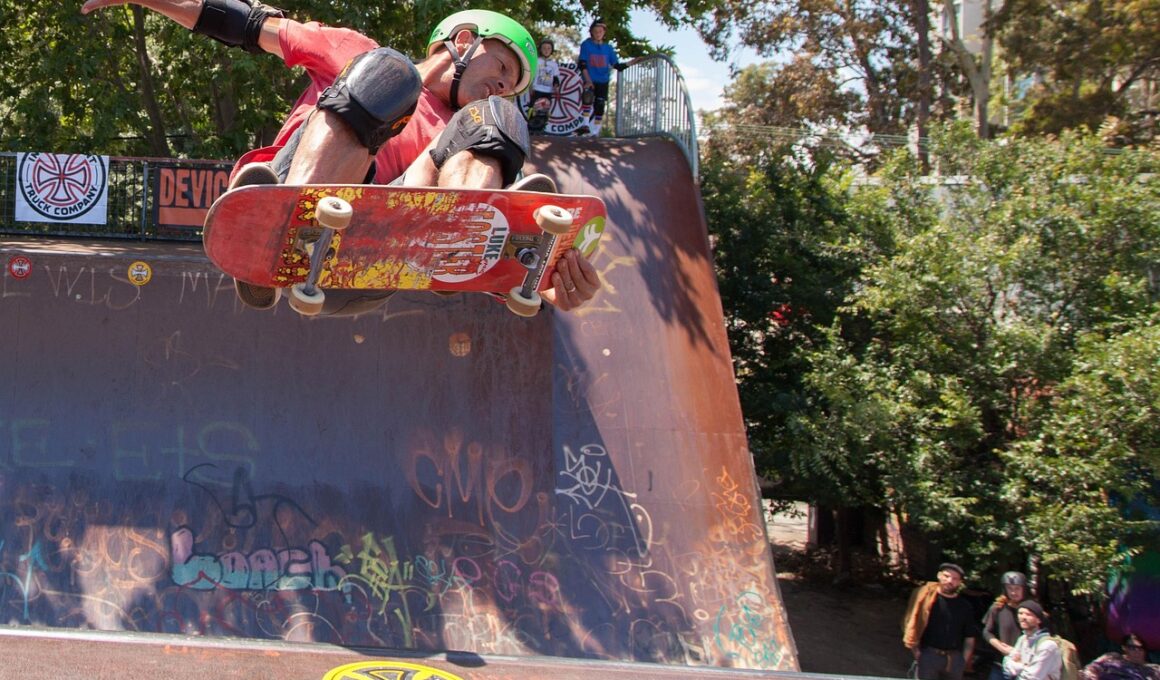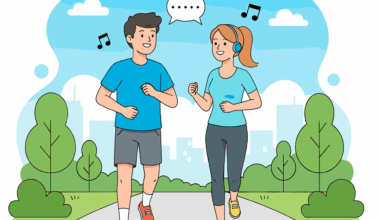Setting Up Your First Skateboarding Practice Routine
Skateboarding is an exhilarating sport that requires both skill and practice. For beginners, setting up a structured skateboarding practice routine is crucial for improvement. To start, you need the right equipment, including a quality skateboard suited to your style. Prioritize safety gear like helmets and knee pads to protect yourself while practicing. Choose a safe and open space such as a skate park or a smooth surface for your sessions. Establishing a consistent schedule is key; aim for at least three practice sessions a week. Each session should be planned with a purpose, such as mastering basic tricks or improving your balance. Warm up before jumping on your skateboard; this reduces the risk of injury. Challenge yourself while remaining realistic with your goals. Break down tricks into manageable steps, focusing on technique before speed. Emphasize gradual progress, as skateboarding can be physically demanding and requires patience. Document your journey by taking notes or videos to track improvements. Most importantly, enjoy the process; skateboarding should be fun! Commit to your routine and witness your skills develop over time in this thrilling sport.
In skateboarding, practicing specific tricks can greatly enhance your overall skill level. Begin with foundational techniques; focus on mastering the ollie, as it’s a fundamental move for most tricks. Practice the ollie on flat ground, ensuring you get the right pop and height. Once comfortable, explore variations like the shove-it, which adds dynamic flair to your routine. Additionally, pay attention to your footing and body positioning, as these greatly impact your performance. Don’t hesitate to incorporate different terrains into your practice. Try skating on ramps, curbs, and rails to diversify your skills. Moreover, consider joining a local skateboarding community or club to gain insights from experienced skaters. Networking with others can provide invaluable tips and motivation. Video tutorials can also offer visual guidance on tricky moves, allowing you to practice more effectively. Furthermore, it’s essential to take breaks to avoid burnout or frustration. If you feel stuck on a particular trick, step back and return with a fresh perspective. Lastly, celebrate small victories; every step forward enhances your confidence and love for the sport.
Developing Balance and Coordination
Another vital element of skateboarding is developing balance and coordination. These attributes can significantly enhance your performance and safety while skating. Begin your practice by focusing on your stance. Position your feet correctly on the skateboard, with the back foot over the tail and the front foot across the board’s middle. This will help you maintain stability and control. Balance exercises off the board can also be beneficial; consider yoga or balance board training. Incorporating these activities will help strengthen your core and enhance your flexibility. Additionally, practice riding in different directions and speeds; this will improve your coordination and adaptability. Never underestimate the importance of a proper warm-up. Stretch your muscles and perform mobility exercises focused on your hips, knees, and ankles. As you progress, attempt to ride with one foot lifted off the ground momentarily; this will challenge your balance and increase your confidence. Join group sessions with fellow skaters to help motivate yourself and each other. Reserve time within your practice routine specifically designated to honing your balance skills. Most importantly, have fun while improving; enjoyment is key to sustained growth in your skateboarding journey.
The environment in which you practice can greatly affect your skateboarding experience. Selecting the right location allows you to practice effectively and safely. Skate parks are designed specifically for skaters and provide various obstacles to challenge your skills. Not only do they promote social interaction with fellow skaters, but they also create a supportive community where tips can be shared. If a skate park isn’t available, look for locations with smooth pavement, such as empty parking lots or quiet streets. However, always be mindful of your surroundings and ensure you are in a legal area to skateboard. Be courteous to pedestrians, motorists, and property owners. As you practice, familiarize yourself with different terrains and obstacles, like ramps and ledges. This variety will help you develop versatile skills. If you’re attempting tricks on your own, consider finding a buddy to watch your technique. They can provide helpful feedback on your performance. Lastly, be prepared for varying weather conditions, as rain or wind can impact your practice. Always keep safety a priority, aiming to skate when the conditions are ideal. Explore your environment and maximize your practice sessions whenever possible.
The Importance of Setting Goals
Setting goals within your skateboarding practice routine can help maintain motivation and provide direction. Clearly defined objectives allow you to focus on specific skills you wish to improve. Start by identifying short-term goals, which can be as simple as learning a new trick within a few weeks. Short-term goals provide a sense of accomplishment and keep you engaged in the practice process. Next, consider long-term goals that span over months or entire seasons; for example, aiming to master a more complex trick consistently. Write your goals down in a notebook or a digital format to monitor progress. Reflect on these goals regularly, adjusting them as necessary based on your growth and interest areas. Don’t forget to celebrate achievements, regardless of size; rewarding yourself encourages further development and keeping enthusiasm alive. Share your goals with members of your skateboarding community; they can offer valuable support and motivation. Moreover, connecting with fellow skaters enlightens you on various techniques, ultimately enriching your practice experiences. Remember, goal-setting in skateboarding should be enjoyable, challenging, and ultimately fulfilling as you strive to improve your skills.
Incorporating flexibility and strength training exercises into your routine is essential for skateboarding success. These exercises will not only improve your performance but also help prevent injuries by strengthening the muscles important for skating. Focus on dynamic stretching exercises before each practice session to enhance your range of motion and prepare your body for skating. Consider activities like lunges, squats, and leg swings to warm up effectively. After your skating sessions, shift to static stretching to cool down and promote recovery. Yoga is another fantastic way to develop body awareness, flexibility, and core strength. Furthermore, integrate strength training exercises at least twice a week. This could include body-weight workouts like push-ups, planks, and squats targeting the core, legs, and upper body. Balance exercises can also improve your overall stability on the skateboard. Use balance boards or stability balls in your training regiment for enhanced results. Always listen to your body during these exercises, ensuring you avoid overstraining your muscles. Ultimately, maintaining a balanced regimen of flexibility and strength training enhances your skateboarding capabilities significantly, making every session more enjoyable and productive.
Building a Skateboarding Community
Engaging with a skateboarding community can significantly enhance your learning experience. Connecting with like-minded individuals can provide motivation and foster enjoyable practice sessions. Seek local skate groups, clubs, or online forums where you can share experiences and receive valuable tips from fellow skaters. These interactions can make the skateboarding journey more rewarding and fun. Look into hosting group sessions at skate parks or other locations, where participants can learn from each other and help with tricks. You might also discover local events or contests that promote camaraderie among skaters. These gatherings offer additional opportunities to learn new skills, share insights, and celebrate each other’s progress. Furthermore, social media platforms can serve as effective tools for finding skating communities and sharing your journey. Document your practice sessions through videos and photos, and engage with fellow skaters by commenting and offering support. This connection can inspire you to push your limits and sharpen your skills. Remember, a supportive community creates a positive environment, motivating everyone to improve and enjoy the thrilling world of skateboarding.
Finally, never forget the importance of having fun while skateboarding. The joy of the sport should always come first, regardless of your skill level. Approach every practice session with an open mind, ready to learn and enjoy the ride. Set aside time for spontaneous sessions where you can skate freely without the pressure of mastering a specific trick. Remember to prioritize your enjoyment and creativity in your practice routine. Explore various skate styles, whether it’s street skating, vert skating, or cruising at the park. Each style offers distinct experiences and challenges, keeping your interest alive. Document your leisure time on the skateboard; capture moments of laughter and camaraderie with friends and fellow skaters. This will remind you of the reasons why you started skating in the first place. Share these experiences through social media or create videos showcasing your journey. Remember that skateboarding is not just about skill but also about connection, exploration, and expression. Capture every moment, regardless of skill level or outcome, as excitement feeds the skateboarding spirit. Commit to improving while enjoying skateboarding at its core.


